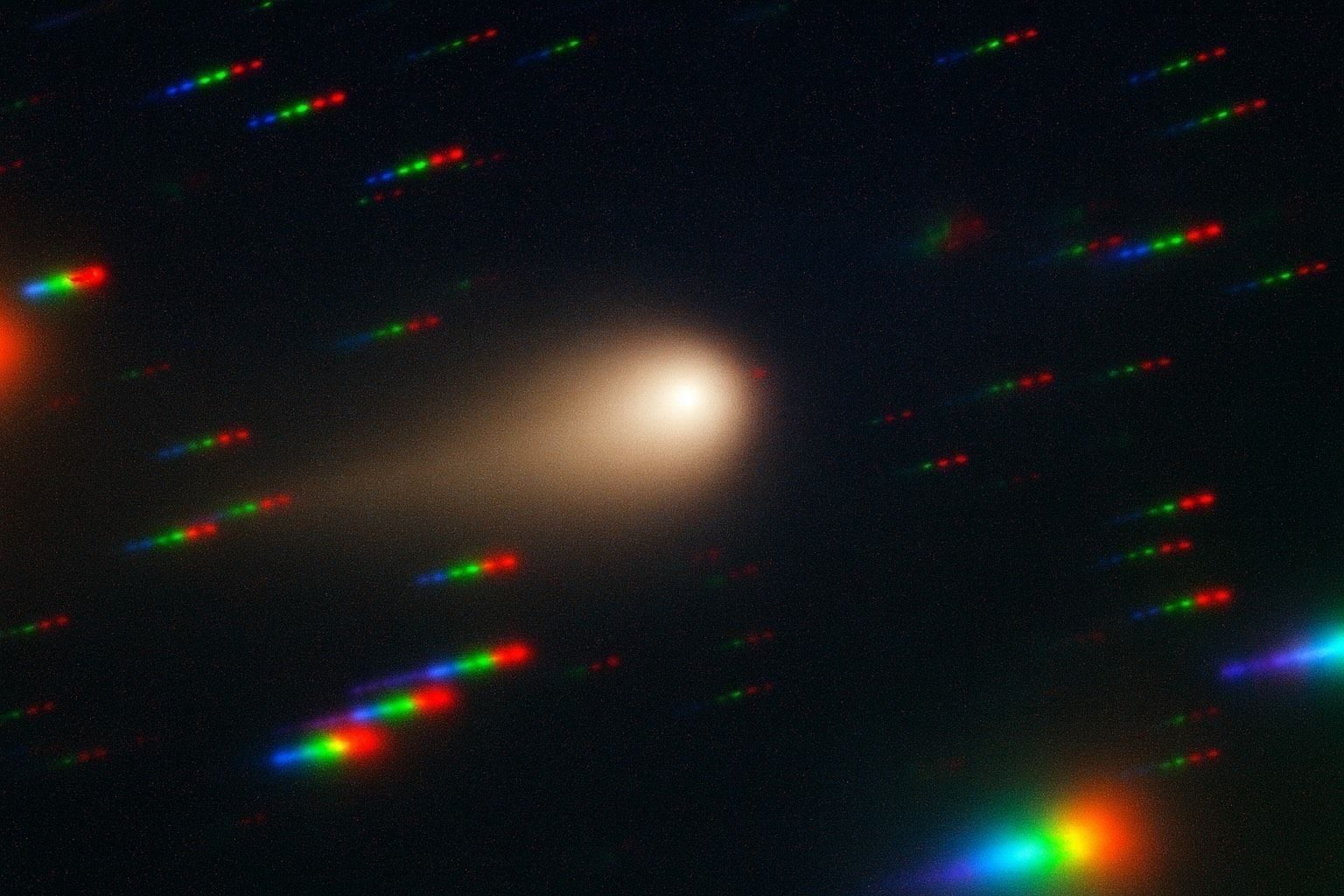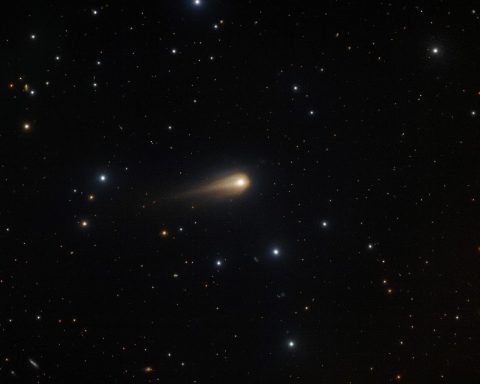Published: November 28, 2025
Interstellar comet 3I/ATLAS – only the third known object from another star system to visit our Solar System – has just stepped into a new role. As of today, it’s the centerpiece of a United Nations–endorsed planetary‑defence exercise, the focus of a huge NASA observation campaign, and the subject of intense online debate over whether it’s a “normal” comet at all. [1]
Here’s a clear, fact‑checked look at what’s actually new on 28 November 2025, why scientists are so excited, what the UN drill really means, and how you can try to see 3I/ATLAS in the sky yourself.
What’s new about 3I/ATLAS on November 28, 2025?
Several threads came together today:
- The UN and the International Asteroid Warning Network (IAWN) confirmed that 3I/ATLAS is the official target of their latest global observing exercise. [2]
- Orbit predictions have tightened thanks to data from Mars‑orbiting spacecraft, confirming yet again that the comet poses no threat to Earth. TechStock²+1
- A major NASA briefing, now widely reported, emphasized that 3I/ATLAS is behaving like a natural interstellar comet, not alien technology. [3]
- New amateur images and social‑media posts are driving viral claims about “impossible” tails, spin patterns and even a “cosmic trap” with another comet – claims that astronomers say are visually striking but not evidence of danger. [4]
Underneath the hype, the scientific picture is clearer – and actually more interesting – than the rumors.
3I/ATLAS: The basics (quick recap)
Before we dive into today’s developments, a refresher:
- What it is: 3I/ATLAS – also known as C/2025 N1 (ATLAS) – is an interstellar comet, confirmed by its strongly hyperbolic orbit (eccentricity ≈ 6.14) that will never loop back to the Sun. [5]
- Discovery: It was found on 1 July 2025 by the NASA‑funded ATLAS survey telescope in Chile and quickly recognized as originating from beyond our Solar System. [6]
- Path: It passed closest to the Sun on 29–30 October 2025 at about 1.36 AU (between Earth and Mars), and will pass closest to Earth on 19 December 2025 at roughly 1.8 AU (~270 million km) – nearly twice the Earth–Sun distance. [7]
- Threat level: Zero. NASA and international teams agree it will not come close to Earth or any planet in a hazardous way. [8]
In other words: this is a rare, scientifically priceless visitor – but not a doomsday rock.
1. UN planetary‑defence drill: What the new campaign really is
Today’s biggest structural change is political and organizational, not physical: 3I/ATLAS is now the official target of the UN‑endorsed IAWN planetary‑defence exercise. [9]
A live‑fire training exercise, not an emergency
According to documentation summarized by the Times of India and technical briefings relayed through IAWN, the comet has been chosen as the focus of the eighth official IAWN observing exercise, backed by: [10]
- IAWN (International Asteroid Warning Network)
- SMPAG (Space Mission Planning Advisory Group)
- The UN Office for Outer Space Affairs (UNOOSA)
Key points:
- The campaign runs from 27 November 2025 to 27 January 2026, with a mid‑campaign review on 9 December and a wrap‑up teleconference in early February 2026. [11]
- Official documents explicitly state that 3I/ATLAS poses no impact risk, never coming closer than about 1.8–2.0 AU from Earth. [12]
- The goal is to practice rapid orbit refinement, coordinated global observations, and clear communication – exactly the skills needed if a truly hazardous object were ever found. [13]
Some tabloid headlines about “UN activating Earth’s planetary defences” are technically based on this drill, but the reality is far more mundane: this is a dress rehearsal, using a safe but scientifically rich target. TechStock²+1
2. Mars spacecraft tighten the orbit – and confirm “no threat”
Another major update feeding today’s news cycle is that spacecraft around Mars have helped pin down 3I/ATLAS’s trajectory far more precisely. [14]
Recent reports highlight:
- In early October, 3I/ATLAS passed about 19–30 million km from Mars, a sweet spot for multiple spacecraft. [15]
- NASA’s Mars Reconnaissance Orbiter (MRO) used its HiRISE camera to image the comet’s coma from about 19 million miles (~30 million km) away, one of the closest views any spacecraft will get. [16]
- NASA’s MAVEN orbiter took ultraviolet spectra, isolating hydrogen and other atoms in the gas cloud around the nucleus, giving clues to composition and water output. [17]
- ESA’s ExoMars Trace Gas Orbiter and Mars Express also observed the comet, allowing teams at ESA’s Near‑Earth Object Coordination Centre to triangulate its position from Mars and Earth simultaneously. TechStock²+1
Using this cross‑planet geometry, orbit modellers report roughly a ten‑fold improvement in orbital precision compared with Earth‑only data. The refined path reconfirms that: TechStock²+1
- Perihelion occurred on 29 October 2025 at 1.36 AU.
- Closest approach to Earth on 19 December 2025 will still be around 270 million km (~1.8 AU) – safely distant.
So the headline here is less “new danger” and more “new confidence that there’s no danger at all.”
3. NASA’s latest verdict: A natural, interstellar comet
With rumors swirling for months about alien probes and hidden engines, today’s coverage of NASA’s latest briefing matters a lot.
A detailed piece from Space.com summarizing NASA’s press conference makes the agency’s stance crystal‑clear: [18]
- 3I/ATLAS looks and behaves like a comet: it has an icy nucleus, a bright coma and a real tail driven by outgassing as it warms.
- More than 20 missions and telescopes – from Hubble and JWST to Mars orbiters and heliophysics missions like STEREO, SOHO and PUNCH – have observed the object across the Solar System. [19]
- Infrared and spectroscopic data show a coma unusually rich in carbon dioxide (CO₂), plus water, carbon monoxide, cyanide and even nickel – all recognised comet ingredients. [20]
NASA officials stressed two points at the briefing: [21]
- No technosignatures – there’s nothing in the data that looks like artificial emissions or engineered propulsion.
- No threat to Earth or other planets – the comet’s closest pass by Earth remains a very comfortable 170 million miles (270 million km), and it will not pass dangerously near any planet, including Jupiter, during its outbound leg.
At this stage, the mainstream scientific view is that 3I/ATLAS is a natural but unusually informative interstellar comet, not a disguised spacecraft.
4. Viral images, “beam‑like” tails and the Avi Loeb debate
Despite NASA’s verdict, today’s news cycle is full of striking images and bold claims that 3I/ATLAS has “broken every rule of comet physics.”
The ultra‑thin tail
A widely shared story from The Economic Times highlights a new image by astrophotographer Mitsunori Tsumura, taken on 22 November 2025, showing a very thin, sharply collimated tail and an apparent lack of curvature. Social‑media accounts describe it as “thin and sharp like a beam.” [22]
Commentary cited in that piece and in Avi Loeb’s blog notes several apparent anomalies in these late‑November images:
- The tail stays unusually narrow and straight, instead of fanning out.
- There is little or no visible curvature, unlike most comet tails that bend because of changing geometry with the solar wind.
- The tail brightness appears to drop off abruptly rather than fading smoothly. [23]
Loeb and others argue that, if you interpret these structures as purely natural gas and dust, they may imply very high mass‑loss rates and extraordinarily dense material in the “anti‑tail” (a tail that appears to point toward the Sun from our viewpoint). [24]
Loeb’s new Jupiter “Hill sphere” argument
In a fresh Medium post highlighted in today’s round‑ups, Loeb also points to a second “coincidence”: the predicted closest approach of 3I/ATLAS to Jupiter on 16 March 2026 is now calculated to be almost exactly at Jupiter’s Hill radius – the boundary of the planet’s gravitational zone of influence. [25]
He notes that:
- Updated non‑gravitational acceleration parameters (small orbital tweaks due to outgassing) nudged the predicted fly‑by distance to roughly 53–54 million km, comparable to the Hill radius at that time. [26]
- If that match remains extremely precise, he suggests it could, in principle, signal some kind of intentional course adjustment by “thrusters” rather than purely random outgassing. [27]
Most dynamicists and planetary scientists, however, regard this as an interesting but very speculative minority view, emphasising that: [28]
- Hyperbolic interstellar orbits are naturally sensitive to small forces.
- Non‑gravitational terms are still being refined as more data arrive.
- The same observations Loeb cites are also consistent with a highly active, CO₂‑rich comet experiencing complex natural jets.
What other astronomers and agencies are saying
Other coverage published today stresses that while amateur images are invaluable, heavy image processing and long exposures can create artefacts that exaggerate fine structure. [29]
- A feature in International Business Times highlights amateur images showing sharp cores, apparent spin waves and opposing straight jets, but quotes scientists who still say the best fit is “an active but atypical interstellar comet”with unusual dust‑to‑gas ratios and jets. [30]
- Another IBTimes story debunks viral claims that 3I/ATLAS and comet C/2025 R2 (SWAN) are forming a “cosmic trap” around Earth, pointing out that the two objects are hundreds of millions of kilometres apart and only appear aligned from our line of sight. [31]
Put simply: the images are real and scientifically intriguing, but they do not overturn the comet interpretation, and they do not mean Earth is in danger.
5. Where is 3I/ATLAS today, and can you see it?
For skywatchers, the practical question is simple: where do I point my telescope tonight?
According to live ephemerides compiled by TheSkyLive and other tracking sites, on 28 November 2025 3I/ATLAS is: [32]
- In the constellation Virgo, climbing away from the Sun after its late‑October perihelion.
- About 290–291 million km from Earth (around 1.94–1.95 AU).
- Shining around magnitude 10–10.5 in recent observations – fainter than the naked‑eye limit, but reachable with moderate amateur telescopes.
Typical rise/transit/set times for a mid‑northern location (e.g., Greenwich, UK) today are approximately: [33]
- Rise: ~01:45–01:50 local time
- Highest in the sky: ~07:40
- Set: early afternoon
Exact times and altitude depend on your latitude and local time zone, but some general observing tips from professional and outreach sources apply globally: [34]
- Use at least a small to medium telescope (80–150 mm aperture) under dark skies; standard binoculars are likely too weak.
- Look in the pre‑dawn hours, roughly 60–120 minutes before sunrise, when Virgo is reasonably high and the sky is still dark.
- Use an up‑to‑date star‑chart, planetarium app or comet‑tracking tool that includes C/2025 N1 (ATLAS) / 3I/ATLAS; the path is being refined as new data come in.
- Expect a fuzzy, diffuse patch of light rather than a dramatic naked‑eye show; this is a deep‑sky target, not a “Great Comet.”
If forecasts hold, 3I/ATLAS should remain a rewarding but challenging object for experienced observers into December, peaking around its 19 December closest approach before fading as it heads toward Jupiter’s orbit. [35]
6. Why 3I/ATLAS matters for science
Beyond the headlines, 3I/ATLAS is a treasure trove for planetary science and galactic archaeology.
A messenger from another star system
Studies combining JWST, Hubble and large ground‑based telescopes indicate that 3I/ATLAS: [36]
- Has a nucleus probably smaller than about 5–6 km, likely closer to the sub‑kilometre range.
- Shows strong CO₂ outgassing relative to water and CO, suggesting it formed far from its parent star, beyond that system’s “frost line.”
- Contains familiar cometary ingredients – water, carbon monoxide, cyanide, nickel and other volatiles – implying that planet‑forming chemistry may be broadly similar across the galaxy.
Dynamical studies cited in today’s explainers note that the comet’s motion is consistent with an origin in the Milky Way’s thick disk or a transition region, and age estimates based on typical stellar populations suggest it could be several billion years older than our Solar System – on the order of 3–14 billion years. [37]
That makes 3I/ATLAS arguably one of the oldest comets we’ve ever studied, a frozen sample of another planetary system’s early history.
A planetary‑defence laboratory
For planetary‑defence planners, 3I/ATLAS is a perfect stress‑test object because: [38]
- Its hyperbolic, high‑speed orbit (eccentricity ~6.14, speeds around 60–70 km/s near perihelion) pushes orbit‑calculation tools to their limits.
- Its extended coma and complex tail make precise astrometry harder than tracking a point‑like asteroid, mirroring challenges we’d face if a real hazardous comet appeared.
- It is high‑profile but harmless, ideal for practising worldwide coordination without alarming the public.
That’s why the UN‑backed exercise treats 3I/ATLAS as a live training target – the techniques refined on this comet could one day make the difference if a truly dangerous object is discovered. [39]
7. Key dates after November 28, 2025
If you’re following 3I/ATLAS from now on, here are the milestones experts are watching: TechStock²+2Star Walk+2
- 27 Nov 2025 – 27 Jan 2026:
UN/IAWN observing window for the planetary‑defence exercise. - 9 Dec 2025:
Mid‑campaign review, where teams compare orbit solutions and data quality. - 19 Dec 2025:
Closest approach to Earth at about 1.8 AU (~269 million km) – prime time for big observatories and serious amateurs. - Late 2025 – early 2026:
Ongoing data releases from Mars missions, heliophysics spacecraft and major telescopes, including more detailed chemistry and jet modelling. - 16 Mar 2026:
Closest approach to Jupiter’s orbit, scientifically interesting for dynamics and the subject of Loeb’s controversial Hill‑sphere speculation. - Early 2030s:
3I/ATLAS will have left the planetary region of the Solar System entirely, continuing its one‑way journey through the galaxy.
FAQ: Quick answers about Comet 3I/ATLAS (as of Nov 28, 2025)
Is 3I/ATLAS dangerous for Earth?
No. Refined orbits using Earth‑ and Mars‑based data show it will never come closer than about 1.8 AU (~270 million km) to Earth. [40]
Could 3I/ATLAS be an alien spacecraft?
A small number of researchers, notably Avi Loeb, have suggested technological scenarios to explain some anomalies. However, NASA, ESA and the vast majority of comet specialists say all current data are consistent with a natural, highly active interstellar comet, and no technosignatures have been detected. [41]
Why does its tail look so weird in some images?
Viewing geometry, strong CO₂‑driven jets and long, stacked exposures can produce thin, straight anti‑tails and complex patterns that look very unusual compared with typical comets. Scientists are actively modelling these structures, but they don’t imply a hidden engine by themselves. [42]
Can I see 3I/ATLAS with the naked eye?
No. At around magnitude 10, it is far too faint. You’ll need a telescope and dark skies, and even then it will appear as a faint, fuzzy patch, not a dramatic streak across the sky. [43]
Why are scientists so excited about it?
Because it’s a physical sample from another star system, older than the Solar System and accessible to a whole fleet of spacecraft and telescopes at once. It lets us test models of comet formation, planetary‑system chemistry and interstellar dynamics in a way we simply couldn’t before. [44]
References
1. timesofindia.indiatimes.com, 2. timesofindia.indiatimes.com, 3. www.space.com, 4. m.economictimes.com, 5. science.nasa.gov, 6. science.nasa.gov, 7. science.nasa.gov, 8. www.space.com, 9. timesofindia.indiatimes.com, 10. timesofindia.indiatimes.com, 11. timesofindia.indiatimes.com, 12. timesofindia.indiatimes.com, 13. timesofindia.indiatimes.com, 14. www.clarksvilleonline.com, 15. science.nasa.gov, 16. www.clarksvilleonline.com, 17. www.clarksvilleonline.com, 18. www.space.com, 19. science.nasa.gov, 20. en.wikipedia.org, 21. www.space.com, 22. m.economictimes.com, 23. m.economictimes.com, 24. avi-loeb.medium.com, 25. avi-loeb.medium.com, 26. avi-loeb.medium.com, 27. avi-loeb.medium.com, 28. en.wikipedia.org, 29. www.ibtimes.co.uk, 30. www.ibtimes.co.uk, 31. www.ibtimes.co.uk, 32. theskylive.com, 33. theskylive.com, 34. starwalk.space, 35. theskylive.com, 36. en.wikipedia.org, 37. en.wikipedia.org, 38. timesofindia.indiatimes.com, 39. timesofindia.indiatimes.com, 40. theskylive.com, 41. www.space.com, 42. m.economictimes.com, 43. theskylive.com, 44. en.wikipedia.org










